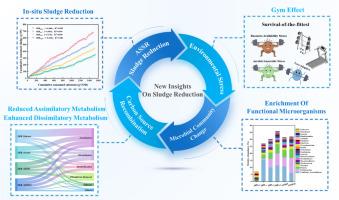当前位置:
X-MOL 学术
›
Water Res.
›
论文详情
Our official English website, www.x-mol.net, welcomes your
feedback! (Note: you will need to create a separate account there.)
The Gym Effect: Unveiling the Role of Microbial Adaptation in Organic Carbon Redistribution and Metabolic Optimization in Anaerobic Side-Stream Reactors
Water Research ( IF 11.4 ) Pub Date : 2025-05-30 , DOI: 10.1016/j.watres.2025.123933
Huanzhong Deng, Chuanhan Chen, Lianpeng Sun, Hui Lu, Miao Wang, Xinzhe Zhu, Chao Yang, Ruo-hong Li
Water Research ( IF 11.4 ) Pub Date : 2025-05-30 , DOI: 10.1016/j.watres.2025.123933
Huanzhong Deng, Chuanhan Chen, Lianpeng Sun, Hui Lu, Miao Wang, Xinzhe Zhu, Chao Yang, Ruo-hong Li

|
Although anaerobic side-stream reactor (ASSR) technology has been proven effective in achieving sludge reduction, current research primarily focuses on specific cellular processes, such as cell lysis-cryptic growth, uncoupled metabolism, and endogenous metabolism. This narrow perspective overlooks the holistic impact of ASSR on mainstream systems. Therefore, this study developed a novel exogenous organic carbon balance model, providing a quantitative framework for analyzing carbon redistribution within the system. The results showed that alternating aerobic and deep anaerobic conditions induced significant microbial community reorganization, selectively enriching functional microorganisms such as polyphosphate-accumulating organisms and denitrifiers. This adaptation altered organic carbon flow, reducing assimilatory metabolism (from 3606.4 mg COD/d in the control group to 2872.5 and 2184.3 mg COD/d in the ASSR group), while enhancing aerobic dissimilatory metabolism (from 1866.1 mg COD/d in the control group to 2175.8 and 2616.4 mg COD/d in the ASSR group), thereby promoting pollutant mineralization and sludge reduction. The innovative concept of the "Gym Effect" was introduced to explain how environmental stress drives microbial adaptation, optimizes metabolic pathways, and enhances pollutant (nitrogen and phosphorus) removal processes (from 34.8 mg COD/g VSS·h in the control group to 49.8 and 66.7 mg COD/g VSS·h in the ASSR group). These findings redefine our understanding of the mechanisms underlying sludge reduction, establishing the relationship between sludge reduction and organic carbon flow redistribution, and providing a robust theoretical foundation for enhancing sludge reduction strategies.
中文翻译:

健身房效应:揭示微生物适应在厌氧侧流反应器有机碳再分布和代谢优化中的作用
尽管厌氧侧流反应器 (ASSR) 技术已被证明可有效实现污泥减少,但目前的研究主要集中在特定的细胞过程上,例如细胞裂解隐蔽生长、解耦代谢和内源性代谢。这种狭隘的视角忽视了 ASSR 对主流系统的整体影响。因此,本研究开发了一种新的外源有机碳平衡模型,为分析系统内的碳再分配提供了定量框架。结果表明,交替的需氧和深度厌氧条件诱导了显着的微生物群落重组,选择性地富集了功能性微生物,例如聚磷酸盐积累生物和反氮化剂。这种适应改变了有机碳流动,降低了同化代谢(从对照组的 3606.4 mg COD/d 降低到 ASSR 组的 2872.5 和 2184.3 mg COD/d),同时增强了有氧异化代谢(从对照组的 1866.1 mg COD/d 降低到 ASSR 组的 2175.8 和 2616.4 mg COD/d),从而促进了污染物矿化和污泥减量。引入“健身房效应”的创新概念来解释环境压力如何驱动微生物适应、优化代谢途径并增强污染物(氮和磷)去除过程(从对照组的 34.8 mg COD/g VSS·h 到 ASSR 组的 49.8 和 66.7 mg COD/g VSS·h)。这些发现重新定义了我们对污泥减量机制的理解,建立了污泥减量和有机碳流再分配之间的关系,并为加强污泥减量策略提供了坚实的理论基础。
更新日期:2025-05-31
中文翻译:

健身房效应:揭示微生物适应在厌氧侧流反应器有机碳再分布和代谢优化中的作用
尽管厌氧侧流反应器 (ASSR) 技术已被证明可有效实现污泥减少,但目前的研究主要集中在特定的细胞过程上,例如细胞裂解隐蔽生长、解耦代谢和内源性代谢。这种狭隘的视角忽视了 ASSR 对主流系统的整体影响。因此,本研究开发了一种新的外源有机碳平衡模型,为分析系统内的碳再分配提供了定量框架。结果表明,交替的需氧和深度厌氧条件诱导了显着的微生物群落重组,选择性地富集了功能性微生物,例如聚磷酸盐积累生物和反氮化剂。这种适应改变了有机碳流动,降低了同化代谢(从对照组的 3606.4 mg COD/d 降低到 ASSR 组的 2872.5 和 2184.3 mg COD/d),同时增强了有氧异化代谢(从对照组的 1866.1 mg COD/d 降低到 ASSR 组的 2175.8 和 2616.4 mg COD/d),从而促进了污染物矿化和污泥减量。引入“健身房效应”的创新概念来解释环境压力如何驱动微生物适应、优化代谢途径并增强污染物(氮和磷)去除过程(从对照组的 34.8 mg COD/g VSS·h 到 ASSR 组的 49.8 和 66.7 mg COD/g VSS·h)。这些发现重新定义了我们对污泥减量机制的理解,建立了污泥减量和有机碳流再分配之间的关系,并为加强污泥减量策略提供了坚实的理论基础。


















































 京公网安备 11010802027423号
京公网安备 11010802027423号